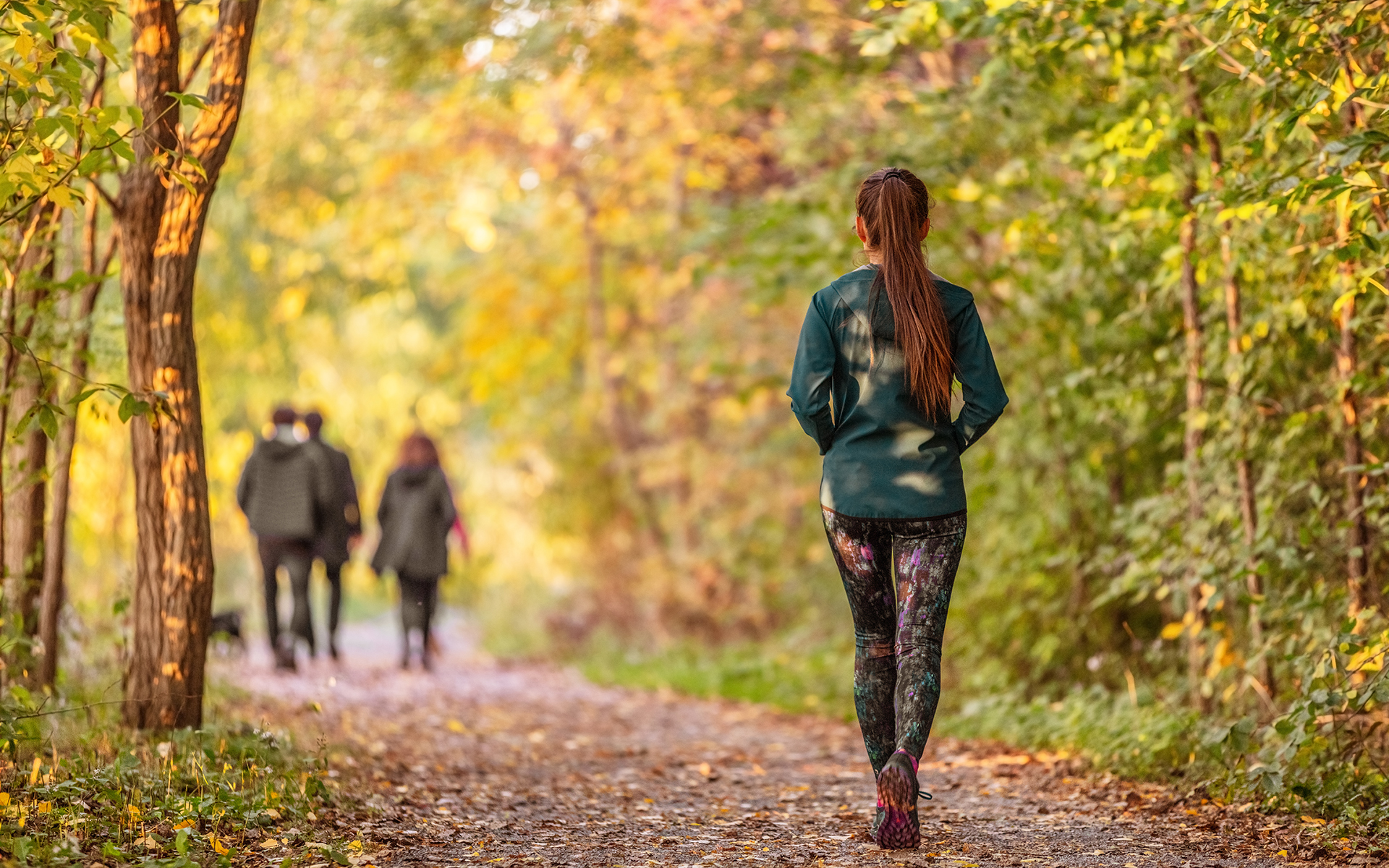Can you see a tree from where you’re sitting right now? How about a plant? Anything living, besides other people? Can you open the window and take a big breath of fresh air?
If your answer to these questions is no, if you’re one of those people who spends all day breathing the lifeless output of a building-ventilation system, then you may be encountering nature deficit. And it’s making your life less enjoyable, less healthy, and more stressed.
We are in the midst of the largest wave of urbanization in human history. The United Nations reports that more than half of all people on Earth now live in cities. For Americans, the figure is even starker: 80% are urban dwellers. And get this: the Environmental Protection Agency reports that the average American spends 90% of his or her time indoors.
“It’s the first time in human history that we are virtually divorcing ourselves from the natural world,” warns Richard Louv, author of The Nature Principle: Human Restoration and the End of Nature-Deficit Disorder. “We can’t expect to make such a sudden, drastic turn in our everyday lives without repercussions.”
It was Edward O. Wilson, known as the father of sociobiology, who pioneered the idea that we have an innate emotional connection with nature. He called it the Biophilia Hypothesis.
And according to Stanford University researcher Gregory Bratman, whose work builds on Wilson’s and focuses on how experiences of nature affect cognitive function and mental health, “Our brains come from a time when we were adapted to natural settings, not urban settings. Seeing trees and growing things naturally kicks up our parasympathetic nervous system and results in our feeling more relaxed. We have an innate connection to nature, given our evolutionary history.”
The problem, Louv points out, is that evolution doesn’t work that fast. It is still in our nature to need nature, and we suffer without it.
“What are the benefits that nature provides for human beings that we’re not paying attention to?” Bratman asks. “Urbanization is increasing at an alarming rate. What are the repercussions for our mental health?”
Current research is showing the cost of our nature deficit, and the converse as well—that reconnecting with nature makes us healthier and happier. For instance, a Japanese study showed that a walk in the forest—stimulating senses of smell, hearing, and touch while under a leafy, green canopy—increases positive feelings, boosts the immune system, and lowers blood pressure. They call it shinrin-yoku—“forest-bathing.”
Meanwhile, the average American spends 90% of his or her time indoors, according to a 2009 report from the Environmental Protection Agency. And it’s not just the concrete jungles and traffic jams of our cities that are divorcing us from nature. “When we sit in front of a computer all day, or video games or television, we narrow ourselves down to the tunnel vision that comes with electronics,” says Louv. “Granted, you can go anywhere in the world on the internet, but you don’t use all your senses. So you’re not fully alive in those places you go.
“Kids used to go outside and spend most of their developing years in nature,” he continues. “Within a few decades, there’s been a virtual disappearance of that relationship.”
Of course, we know intuitively that we need green. The problem for urban dwellers is how to get it. It’s hard to pick up and move to the country. Most of us can’t afford a weekend cottage by the lake. And a rushed walk past a park on the way to work doesn’t cut it. Here are three ways to reconnect with nature in the midst of a busy modern life.
Make a Relationship
“I have a daily practice where I sit in silence for 20 minutes and watch my breath,” says David Haskell. “Over the years it’s been very important to me, and I wanted to see if I could bring that approach to the study of biology.”
Like most biologists, Haskell was fascinated by nature as a child and spent his time poking around the gardens and woods near his home on the outskirts of Paris, France. Today he is a professor of biology at the University of the South in Sewanee, Tennessee, and the author of The Forest Unseen: A Year’s Watch in Nature.
The book documents Haskell’s year of daily visits to one small patch of old-growth forest near the university cam- pus. “The practice of repeatedly giving my attention to one patch of Earth over a year caused me to open up my senses and to see more of the biological wonders of the world,” he says. “I realized how much I didn’t notice in everyday life because I wasn’t paying attention, how often my senses and attention were turned off. It was a good reminder to turn them back on—to see the changing quality of light through the seasons or how the soundscape changes through a day.”
By painstakingly observing—every day for 12 months, sometimes for hours at a time—the trees, bushes, flowers, birds, and animals of that patch of forest, Haskell broke down the all-too-common perception that nature and humanity are separate. “That dissolved for me. I had
a sense of being part of a community of life. A very small area can offer a window to the whole. To sit down and watch one little place—it’s like using a pinhole camera to see much larger patterns.
“For example, many of our drugs and antibiotics originally come from the soil, from obscure little soil fungi and microbes. It’s those tiny things and their interactions that produce the chemical complexities we can use in medicine. Yet how often in a doctor’s office are you reminded that these drugs you’re taking actually came from the soil?”
We don’t have to take it to the lengths he did, but Haskell believes everyone can benefit from the practice of connecting with a natural phenomenon of our choice.
“Pick something and give it your attention, repeatedly, for a year,” he suggests. “Trees, a park, flocks of pigeons. Most people don’t have the time to spend hundreds of hours looking at a forest. But it can be a short practice, just committing a few minutes each day.”
Haskell tells the story of a city-dwelling friend who pays attention to one particular tree every day. “It’s the only green thing in his world, but every day as he goes to the subway, he checks in with the tree. What color is it today? Are any animals interacting with it? Touching base with that one natural thing makes him more connected to nature than many people I know who live in the country—because he’s made a practice of giving his senses to a particular part of the natural world on a regular basis.”
These days, Haskell says, “I don’t go to the same patch of forest as often. But when I can, I get out to some natural area every day and try to pay attention.” He says that his year of forest visits gave him a renewed sense that we find wonder and amazement in the world by giving it our attention.
“The same is also true for the cultural and human histories of a particular area—the more we give them our attention, the more interesting they become, the more richly variegated,” says Haskell. “That realization is very enriching in many different aspects in life.”
Restore Yourself
If you live in Cleveland, you can get back to green in the Elizabeth and Nona Evans Restorative Garden within the city’s 10-acre Botanical Garden. There you can sit in the dappled shade of two grand oak trees and a Yulan magnolia, carefully positioned so you can hear the wind rustle its leaves.
“One of the things we try to do is help people pause,” says landscape architect David Kamp, who designed the garden. “Sometimes if you just pause, your frame of mind changes.”
The Restorative Garden offers three distinct settings with different functions and moods. One is the Garden for Horticultural Therapy, which hosts programs for people with special needs. It is sunny and active, with stimulating colors and smells. And, as Kamp notes, everyone has needs for nature.
“The whole idea was to invite everyone into the garden,” he says. “We were conscious not to design it only for special needs. One of the things I believe in very strongly, and so do the garden administrators, is that nature is beneficial for everyone.”
Kamp’s favorite feature here is the Basil Walk. “It has narrow paths along which we planted 12 varieties of basil, and as you pass by it, the basil brushes against you. You carry the scent home with you. I must admit, we didn’t plan it that way. It’s serendipitous.”
In July, the basil garden hosts a food program, where people are invited to make pesto and different kinds of tea. “We have plants that are fragrant, colorful, and very tasty. We have plants that are fuzzy and plants that are waxy,” says Jennifer McDowell, the director of guest and member services at the Botanical Garden. “It’s a great sensory experience.”
Another setting, the Contemplative Garden, was created for calm and serenity. It was designed with muted colors and fragrances, and a water feature muffles outside noises. “Because it is the highest part of the garden,” says Kamp, “it’s what most people would think of as a contemplative space.” It’s here that you can connect with those two great oaks and sit under the canopy of that Yulan magnolia.
The Garden for Learning and Exploring is more interactive. Free classes take place here, such as the program designed to connect seniors with seasonal flowers and herbs. The garden slopes about six feet from one end to another, with two different terraces and a retaining wall with water cascading down its face to pools below. “You can sit and listen to the sound of the water,” says Kamp. “There are rocks sparkling with mica you can touch. There are plants you can touch.”
Based on their Cleveland success, the designers of the Restorative Garden were asked to create a channel garden at New York’s Rockefeller Center. “It’s right in the middle of Manhattan, one of the busiest tourist spots in the city,” says Kamp. “We tried to create a place with intimacy, where someone could pause in their busy day, where you could just stop for a minute. It changes your perspective.”
Get Dirty
One of Peter Good’s earliest memories is going out with his father to their backyard vegetable garden in small-town Pennsylvania and digging in the dirt.
“My father was in the tree business, but for him it was more than a business. It was a calling,” Good says. “He handed down to me the joy of getting dirty up past my elbows, of helping make something grow. And when you taste the sweetness of something freshly picked that you planted with your own hands, it’s medicinal. We need that.”
Good moved to San Francisco 30 years ago and started designing and building urban gardens. When you drive with him up and down the hills and around the waterways of the Bay Area, he tells you what grew before people were around and what people planted since. He talks about soil like some people talk about foie gras. “As far as I’m concerned, you don’t fully know where you live until you’ve churned up the topsoil and explored what lies beneath,” he says.
Good is a big fan of Brooke Budner and Caitlyn Galloway, who operate Little City Gardens in San Francisco and serve restaurants, residents, and farmers’ markets. They’re now tilling an acre in the Excelsior district, a modest residential neighborhood where Good and his crew have just installed an irrigation system for them. What he’d really love to do is uncover (or “daylight”) a stream that runs beneath the urban farm—the city covered it more than 50 years ago—and plant vegetables along its banks. But that’s a dream for another day.
Budner and Galloway are local heroes for successfully lobbying the city to allow urban farming. The folks who urban-garden love the food they grow, but they love something else just as much. They get a chance, says Budner, “to be outside, to have a break from their indoor lives, their computer lives. They get to use different parts of their bodies and they enjoy a landscape that doesn’t involve a window.”
San Francisco’s architecture offers lots of flat roofs, which make perfect gardens. “I was planting a set of onions the other day on my roof, and I flashed on that memory of my dad teaching me to dig in the garden,” Good says. “Call it nostalgia or whatever, but it gave me an idea.” Good climbed down from the roof and looked for his neighbor’s four-year-old son. He helped the boy plant the onions in a little spot in his front yard.
“Digging in the dirt is in our DNA,” Goode says. “It’s harder to do that in the urban environments most of us live in now, but it’s not all that hard. Get out there on a sunny weekend, plant a seed, and take a kid with you. You’ll love it.”
read more
How Walking In the Woods Helped Ease My Anxiety
Once writer and health researcher Misty Pratt stopped fighting nature, she was able to see its beauty, and how she is connected to it.
Read More
A Guided Walking Meditation to Connect with Your Senses
Mindful walking can be a way to awaken our delight as we notice the sights, smells, and sounds in our surroundings.
Read More
Two Mindfulness Practices to Connect with Nature
Celebrate Earth Day by tuning in to the rhythms of the earth.
Read More










